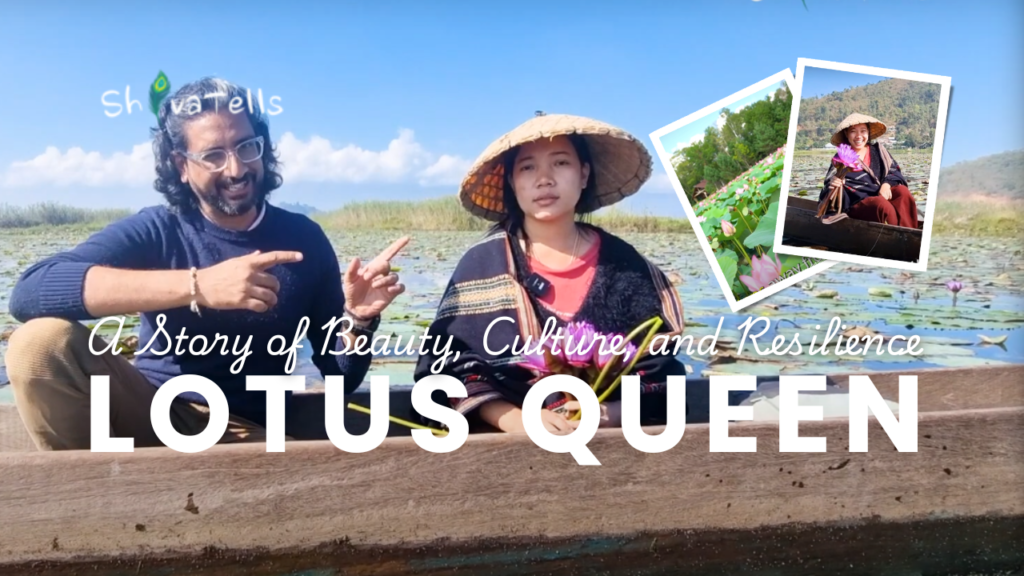There’s something magical about Manipur. The rolling hills, the serene lakes, and the vibrant traditions—it all feels like a dream. But on my recent journey, I discovered a story that felt straight out of folklore. A queen who isn’t royal by birth, yet she rules over a kingdom of pink blossoms. A woman whose life is as delicate as a lotus, yet as strong as its roots in the mud. This is the story of the Lotus Queen of Manipur—a woman whose bond with the Loktak Lake’s sacred lotus has made her a symbol of beauty, culture, and resilience.

Table of Contents
The Kingdom of Floating Lotuses
My journey started at Loktak Lake, the largest freshwater lake in Northeast India. But this is no ordinary lake—it breathes. The surface is dotted with phumdis—floating islands made of organic matter. These moving landmasses create a magical landscape, making Loktak look like a dream woven in green and blue. But what caught my attention were the endless pink lotuses blooming on the water. And that’s when I heard about the woman who spends her days among them. Locals call her the Lotus Queen. She isn’t royalty in the traditional sense, but in the world of lotus farming, she is unmatched.
Meeting the Lotus Queen

On a crisp morning, I hopped onto a small boat with a local guide and set out to meet her. The boat glided through the floating islands, the mist hovering over the water like a thin veil. After about twenty minutes, we reached a spot where the lotuses bloomed in thousands. And there, in the middle of the lake, stood a woman dressed in a simple phanek (traditional Manipuri wrap), her hands gently picking lotus flowers from the water.
Her name is Ibemhal Devi, but everyone in the region calls her the Lotus Queen.
She greeted me with a warm smile and invited me onto her floating phumdi. As I stepped onto the soft, spongy land, I realized that this was her world—a world of pink petals, calm waters, and silent resilience.
A Life Rooted in the Lotus

Ibemhal has been harvesting lotus flowers for over twenty years. She wakes up before sunrise, rows her small boat to the heart of the lake, and carefully plucks each bloom with the precision of an artist.
For her, the lotus is not just a flower—it’s life itself.
- It feeds her family – The lotus stem, locally called thambou, is a key ingredient in Manipuri cuisine.
- It is her livelihood – The flowers are sold in markets and temples, where they are offered to the deities.
- It is her legacy – She learned the art of lotus farming from her mother, who learned it from her grandmother.
“I have spent my whole life with these flowers,” she said, gently holding a fully bloomed lotus in her hand. “They are as strong as they are beautiful. Just like us women.”
The Sacred Connection Between Manipur and the Lotus

In Manipur, the lotus is more than just a flower. It is woven into the fabric of culture, spirituality, and daily life.
1. The Divine Flower
The lotus holds deep religious significance. It is offered to gods and goddesses in every Manipuri temple, especially in the famous Govindajee Temple in Imphal.
2. A Culinary Treasure
The lotus stem is a delicacy in Manipuri cuisine. It is used to make delicious dishes like Eromba (a traditional mashed vegetable dish with fermented fish) and stir-fried with bamboo shoots.
3. A Symbol of Strength
The lotus blooms in muddy waters, yet remains untouched by dirt. It represents resilience, purity, and the spirit of Manipuri people, who have faced hardships yet continue to thrive.
The Challenges of Being a Lotus Queen
But being the Lotus Queen isn’t easy.
1. Climate Change is Altering the Lake
The shifting weather patterns have started affecting the growth of lotuses and phumdis. The once-abundant flowers are becoming harder to find.
2. Urbanization Threatens the Tradition
With modernization creeping into the region, many younger generations are leaving behind traditional farming practices for city jobs.
3. Pollution is a Rising Concern
Despite being a sacred lake, Loktak is not immune to pollution. Waste from nearby areas sometimes flows into the lake, affecting the ecosystem and the lotuses.
Yet, Ibemhal refuses to give up.
“I will keep harvesting as long as the lake allows me,” she said, looking out at the water. “The lotus has never abandoned me. I won’t abandon it either.”
Why You Must Visit the Land of the Lotus Queen

If you ever visit Manipur, meeting the Lotus Queen is a must. Here’s why:
1. Experience a Floating World
Sailing through the lotus fields of Loktak Lake feels like stepping into a painting.
2. Witness a Dying Tradition
Lotus farming is an ancient art that few practice today. Seeing it firsthand is witnessing history.
3. Taste Unique Lotus-Based Dishes
From lotus stem curry to fresh lotus seed snacks, the flavors will surprise you!
4. Support Local Farmers
By buying freshly harvested lotuses from local women like Ibemhal, you help sustain a tradition that has existed for generations.
Best Time to Visit & Travel Tips
If you’re planning to visit the kingdom of the Lotus Queen, here’s what you need to know:
- Best Time to Visit: September to November, when the lotus flowers are in full bloom.
- How to Reach Loktak Lake:
- From Imphal, take a taxi or bus to Moirang (around 45 km away).
- From Moirang, hire a local boat to explore the lake.
- Where to Stay:
- Sendra Tourist Lodge – Offers breathtaking lake views.
- Homestays in Thanga Village – Perfect for an authentic experience.
The Legacy of the Lotus Queen

As I bid farewell to Ibemhal, I realized that her story is more than just about flowers—it’s about resilience. In a world that is changing too fast, she stands rooted like a lotus in the water. Unshaken. Proud. Holding onto a tradition that may soon disappear. She doesn’t wear a crown, yet she reigns over a world of pink blossoms. She doesn’t rule a kingdom, yet her hands hold a power that keeps an ancient culture alive. She is the Lotus Queen of Manipur—and her story deserves to be told.
Read More Stories From Manipur
- Loktak Lake: Shiva Tells’ Unforgettable Adventure in a Floating Paradise!
- Thang-Ta Manipuri Martial Art: A Legacy of Warriors and Dance
- A Journey to the Heart of Meitei Tribe Culture: Andro Village
